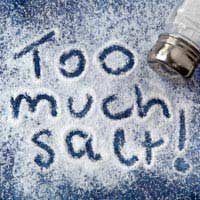Salt and Children's Food

Eating too much salt is unhealthy for both children and adults. Children who eat higher levels of salt have higher blood pressure, and this can continue into adulthood, where it increases the risk of heart attack and stroke. Higher salt levels are also linked with worsening asthma and increasing the risk of osteoporosis.
How Much Salt Should Children Have?
The Food Standards Agency (FSA) has set safe levels for children’s daily intake of salt:- 0-6 months – Less than 1 g/day
- 7-12 months – 1 g/day
- 1-3 years – 2 g/day
- 4-6 years – 3 g/day
- 7-10 years – 5 g/day
- 11-14 years – 6 g/day
These are maximum levels – it’s perfectly healthy for children to have less salt than this.
Adding Salt to Food
Food cooked for children (or adults as well) shouldn’t have any salt added to it – as children get older, add flavour to food using spices and herbs. Not adding salt to cooking may make the food taste bland at first, but after a while, the need for salt will drop.Don’t have a saltshaker on the table – many adults add salt to their food out of habit, and children will copy this.
Hidden Salt in Food
About three-quarters of the salt in the diet comes from processed food. This can include foods that don’t taste salty, including cereals, bread and sweet foods like biscuits, cakes and muffins.Choose lower-salt versions or no added salt of food, such as baked beans, pasta sauces and tinned vegetables. Many manufacturers are reducing the amount of salt in their foods, but the levels may still be high.
Food packages should be labelled with the amount of salt – this may be listed as ‘salt’, ‘sodium chloride’ or just ‘sodium’. If the listing is for sodium, this needs to be multiplied by 2.5 to get the amount of salt.
Check whether this is per pack, per portion or per 100 g (and some portion sizes are really rather small, which makes the salt content look rather low), Some packages may label the salt content as ‘high’, ‘’medium’ or ‘low’, or have red, amber and green traffic light labelling.
How to Cut Down On Salt
As the majority of salt comes from eating processed and junk foods, switching food choices, moving to freshly prepared food and eating healthy snacks will immediately cut the levels of salt. This will also cut levels of fat, sugar and calories, and so help with weight control. However, when preparing food at home, it is important to remember that ingredients like cheese, cured meats (for example bacon, ham and salami), smoked fish and stock cubes are also high in saltSome switches are quite simple:
- Swap cornflakes for porridge oats or homemade muesli
- Swap crisps and dry-roasted peanuts for unsalted seeds and plain nuts, including peanuts roasted in their shells
- Swap tinned tomato soup for tomato soup made with fresh or tinned tomatoes
- Swap ordinary baked beans for reduced-salt baked beans
- Swap tinned sweet corn in salted water with frozen or fresh sweet corn
- Swapped tinned tuna in brine with tinned tuna in water

Re: Superfoods on a Budget
I just checked out these fantastic tips for buying superfoods on a budget! Eating healthy doesn’t have to be expensive. Can’t wait to try…
Re: Fun Facts: How Many Calories Does a Child Burn?
hi, im eleven yrs. I weigh about 100 lbs and believe I am over the normal weight. I am about 4’10 ft. I…
Re: Fun Facts: How Many Calories Does a Child Burn?
I want to clear this up for everybody worried about their weight, especially at a young age you shouldn’t…
Re: Dealing with a Child that is Always Hungry
I am the great grandmother of an 8 year old that I mostly take care of her mom is around but she totally depends…
Re: Fun Facts: How Many Calories Does a Child Burn?
I’m 11 years old and recently got a smart watch. This isn’t a big question but I can’t find how many…
Re: Dealing with a Child that is Always Hungry
I'm immediately suspicious of an article that suggests cereal as a healthy snack. Cereal (especially cereal…
Re: Fun Facts: How Many Calories Does a Child Burn?
How many calories SHOULD an average twelve year old burn daily???
Re: Fun Facts: How Many Calories Does a Child Burn?
I'm 9 years old and I'm trying to set up a health journal but I don't know how many calories I should…
Re: Fun Facts: How Many Calories Does a Child Burn?
Hiw much calories should an average 10 year old burn a day?
Re: Dealing with a Child that is Always Hungry
I’m 16 and my sister is 11 years old 57 inches and weighs 90 pounds she only drinks like 2 or 3 16 ounce bottles…